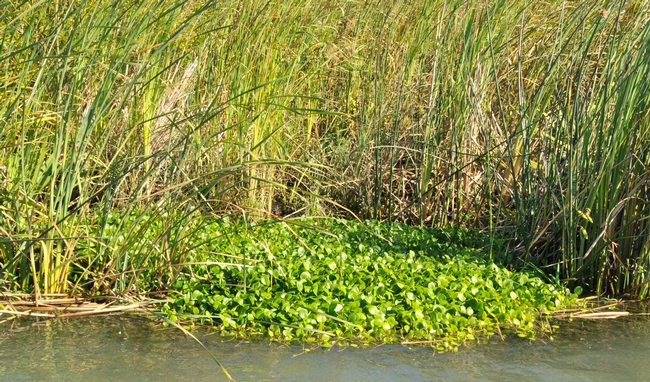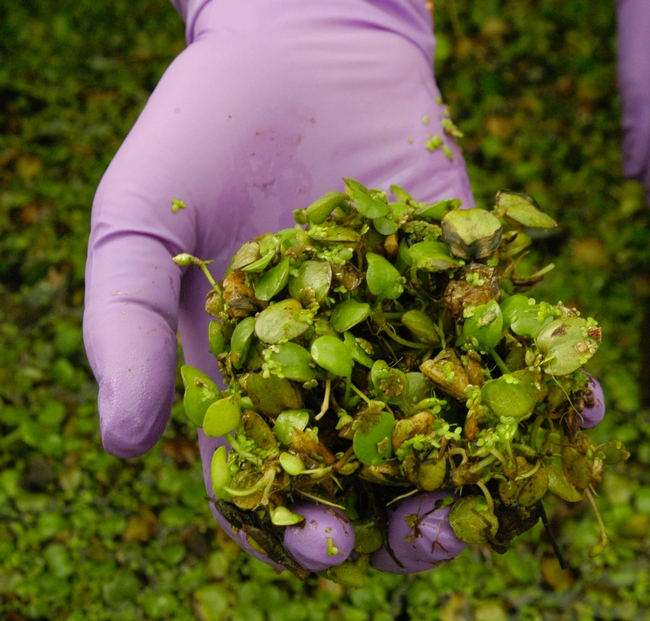Since the early 1980s, the California Department of Boating and Waterways (BWW) has been increasingly successful in managing two invasive aquatic weeds in the Sacrament-San Joaquin Delta: water hyacinth (Eichhornia crassipes) and Brazilian waterweed (Egeria densa). Now, over the past few years, a new threat has emerged: South American Spongeplant (Limnobium laevigatum). A native of South America, Central America and Central Mexico (as the name implies), this is a prolific, floating, flowering plant in the “frogbit” family (Hydrocharitaceae).
Spongeplant infestations were first found in 2003 in small ponds in Redding and Arcata, CA, but more was discovered in the San Joaquin River by CDFA and USDA-Agricultural Research Service in 2007, and in the Sacramento-San Joaquin Delta (Delta) in 2008- 2011.
Mature plants resemble small, densely packed water hyacinth (see image below), but rather than the very showy, purple flowers of water hyacinth, South American Spongeplant flowers are quite small (ca. 1 cm across) and inconspicuous below dense canopies. However, like waterhyacinth, South American Spongeplants spread vegetatively, as well as through abundant seed production. The spongeplant seeds germinate rapidly to produce extremely small (2 to 4 mm), floating seedlings that outwardly look like “duckweed”. The seedlings are easily dispersed by wind, currents, and tidal action in the Delta. A single handful can contain over 60 fully expanded seedlings ranging from 1 to 3 cm in diameter (see image below).
Little is known about growth rates, nutrient requirements and cold-tolerance in South American Spongeplant, so our USDA- ARS laboratory at Davis is examining those characteristics now. But it is clear from the past winters that the small seedlings (e.g. from 0.2cm to 2 cm diameter) can easily withstand frost and our mild freezes since they are well protected as they float on the water among the frost-bitten water hyacinth, cattails and tules. The large mats seen in the San Joaquin River and the Delta suggest that spongeplant has the capacity to cover large areas of open water and render them ill suited for healthy fish and wildlife habitat and problematic for critical Delta pumping and irrigation delivery systems.
What’s being done? The key, as with all new infestations is a Rapid Response: containing, removing or killing the plant. However, controlling the infestations in the Delta will be a challenge due to tidal flows, net river flows, and the likelihood of widely dispersed populations, some of which will be “out of sight” behind the taller plants. Both BWW and California Department of Agriculture (CDFA) crews have had some success in physically removing plant, and efforts by CDFA on earlier discoveries in small ponds have reduced or eliminated infestations by using herbicides. To strengthen control efforts, the USDA-ARS Exotic and Invasive Weed Research laboratory on the UCD campus has included South American Spongeplant in its Rapid Reponses research program.
*NOTE: To access a more detailed article on South American Spongeplant, click on these links below to the California Invasive Plant Council (Cal-IPC) newsletter article by Lars Anderson (USDA-ARS) and Pat Akers (CDFA):
Newsletter Article:
http://www.cal-ipc.org/resources/news/pdf/Cal-IPC_News_2011Spring.pdf
Cal-IPC site: http://www.cal-ipc.org/resources/
Attached Images:

Spongeplant- Brannan Island, Sacramento-San Joaquin Delta

Handful of young South American Spongeplants (Note: There are several duckweed plants attached to these large seedling)